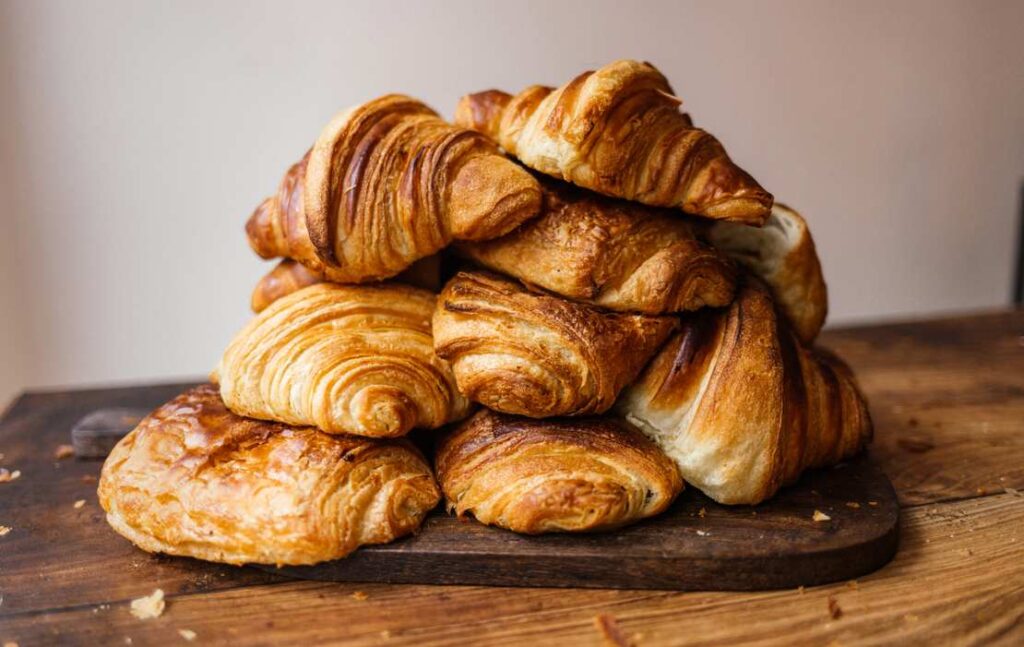Delicious Croissant with the crispy layers of golden flake, as well as the buttery aroma. Be it a bun for breakfast, a midday snack, or with coffee in an empty café, the croissant defines the essence of French baking. Ironically, today no one is deceived anymore by the subtleties that a croissant presents in reference to its origins because of its associations with French cuisine, where, as a matter of fact, it comes from elsewhere-better put in the shape of a story marked by history, craftsmanship, and cultural exchanges.
Origins of the Delicious Croissant
While the Delicious croissant is a staple of some of the baked goods within France’s bakeries, the origins of the Delicious croissant stem from Austria. The origin of the croissant is said to come from the **Kipferl** crescent-shaped pastry dating back at least to the 13th century. It is legend that the bakers still working late into the night during the 1683 Ottoman siege of Vienna heard the Turks tunneling under the city and sounded the alarm, thus saving the city from invasion. They baked crescent moon-shaped pastries from the flag of the Ottomans and named them Kipferl. Success was celebrated by baking crescent moon-shaped pastries from the flag of the Ottomans and naming them Kipferl.

This modern Delicious croissant emerged as a result of Austrian entrepreneur **August Zang** opening a Viennese bakery in early 19th century Paris. Overnight, Zang’s “Miniseries,” consisting of Kipper’s, sold overnight in Paris, and the French bakers soon adapted the recipe to incorporate butter laminated dough; thereby giving birth to the modern croissant: lighter, flakier, and more delicate than its precursor from Austria.
Art of Delicious Croissant Manufacturing
This magic is captured in the buttery, multi-layered texture of a croissant manufactured through a labor-intensive technique called **lamination**; that perfect croissant would be exacting and a process of patience. Dough used consists of flour, water, yeast, sugar, salt, and butter. Folding and rolling this dough creates a layer of butter inside what marks a difference between croissants and regular pastries.
1. Dough Rolling and Lamination: Roll and fold the dough onto a big block of butter. This involves folds of dough over butter and rolls again in lamination. “This process repeated several times created hundreds of layers of dough and butter like paper.”.

2. Proofing and Baking: The dough is rolled into triangles, and then rolled up in the classic crescent shape. The croissants will go through the process of proofing before baking. It is in that process that they take on that sort of lightness characteristic of the croissant. Moisture inside the butter turns into steam once the croissants enter the oven; puffed up that dough can be as flaky and airy as a croissant.
Types of Delicious Croissants
A true real croissant, in fact, is quite straightforward and very simple; but bakers, over time came up with just a multitude of varieties of their own take on the original Pad Thai.
Pain au Chocolate : One of the most popular variations in fact includes rich, dark chocolate within the folds of the pastry to provide great contrasts between the doughy richness of the buttery pastry and the richness of the chocolate.
Almond Croissant: I fill the croissant with almond paste and then top it with sliced almonds. Rich, sweet, good for indulging only once a year.
Filled Croissants: You can really fill croissants with anything. Ranging from rather savory things like ham and cheese, custard, fruit preserves or even Nutella as a sweet filling.
The Global Appeal of Delicious Croissant
This pastry is originally from Europe but found anywhere in the world. Today, it’s still a very common morning bread product and, above all, eaten with coffee or filled only with butter and jam. It’s easily found in bakeries and groceries across America, sometimes stuffed with bizarre fillings or even used as a sandwich base. For example, in Japan, they are smaller, sweeter, and filled with matcha or red bean paste for an extra local flavor.
The “cronut”-a cross between a Delicious croissant and a doughnut-caught headlines recently and it shows that something as humble as a croissant can be taken to great depths.
The Delicious croissant is also great to such flexibility and sheer hedonism when eating it. Its crispy flaky skin on the outside with soft butterine’s within are textural delights while the relatively mild flavor will just let the croissant balance both sweet and savory ingredients in just the right proposition. Be it plain-filled or dipped in coffee, the croissant is just lovely for that indulgence after every take.

And Delicious croissant, probably, is the most artistic bake. Lamination made it a fragile masterpiece requiring sensitivity and fine touch. Ideal for croissant work, because that brings together all those factors. In many respects, the croissant is the quintessence of the French bake: sophisticated, subtle, and steeped in tradition.
Conclusion
A Vienna icon, the croissant, took over the world from there as well. The loosely textured yet richly buttery layers and then flexibility-it’s been this treat for the ages, constantly reinventing itself without missing the classic allure of the past. From being drenched on a balcony over Paris or played with by some creative cat in the city of your choosing, a croissant is just a form of revelry in the wonders of good pastry well done.
FAQS
What gives croissants their taste?
Additionally, using a bland butter will result in a boring croissant because the butter contributes so much to the croissant’s flavor.
What are croissants famous for?
Inspired by the shape of the Austrian kipferl, this buttery, flaky viennoiserie pastry is made with French yeast-leavened laminated dough. Because of its historical crescent form, croissants got their name.
Are croissants tasty?
Nothing compares to the taste of a freshly made croissant. The reward for mastering the technique of laminating dough is incredibly sweet, but it requires time and effort. This recipe is a true work of love and always produces pastries that are flawlessly pillowy and flaky.
What makes a croissant unique?
The butter-filled dough is folded into layers to generate the distinctive features of croissants, including its crunchy crust, airy crumbs, honeycomb-shaped cross section, and deep buttery scent.
Who is known for croissants?
The croissant recipe was first documented in French by Sylvain Claudius Goy in 1915. Goy changed the recipe to utilize a laminated yeast dough in place of the brioche dough that August Zang had used. To make thin, flaky pastry layers, lamination entails folding dough and butter.



Your point of view caught my eye and was very interesting. Thanks. I have a question for you.
please ask me a question
I don’t think the title of your article matches the content lol. Just kidding, mainly because I had some doubts after reading the article.
Thank you for your sharing. I am worried that I lack creative ideas. It is your article that makes me full of hope. Thank you. But, I have a question, can you help me?